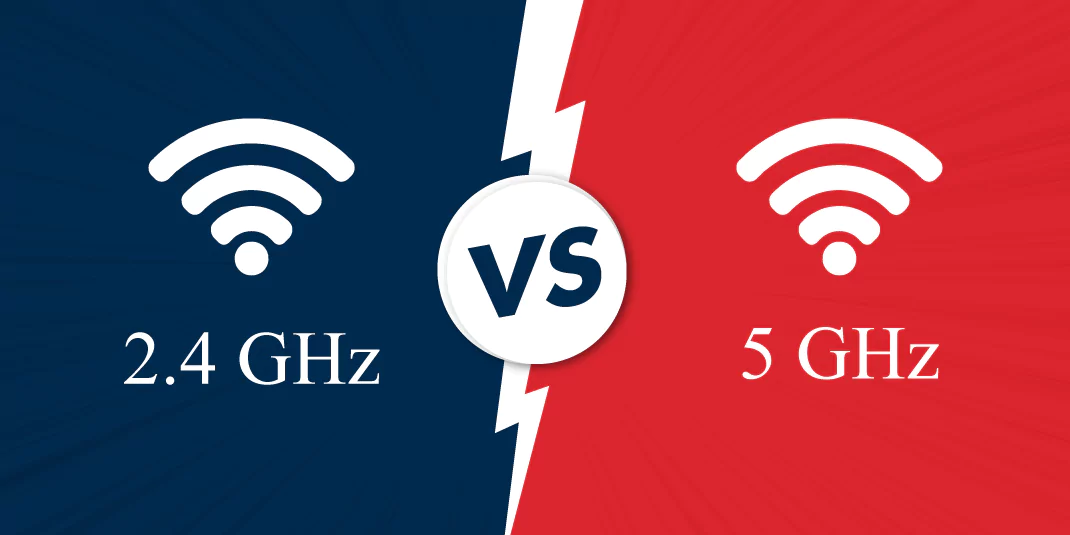WiFi routers have become common in many households to address the changing internet requirements raised due to our collective lifestyle.
Over time, there have been numerous WiFi standards to improve the range and speed of our routers. Since WiFi 4’s release, many routers have shifted from single-band to dual-band, allowing them to choose between the two WiFi frequency bands, 2.4 GHz and 5GHz, to transmit data. So, what are frequency bands, and how do they differ? And which frequency band should you use?
What are WiFi Frequency Bands?
A frequency band is a frequency range of radio waves used to transmit data. These frequency bands can be further broken down into WiFi channels.
In simple words, WiFi frequency bands are radio wavelengths used by routers to transmit WiFi signals. The higher the frequency, the higher the transmission speed and the shorter the coverage area. Another notable thing is that these bands are susceptible to interferences, which is why your devices sometimes receive poor signals. Your WiFi router primarily uses 2.4 GHz and 5 GHz frequency bands to connect your devices to the internet.
2.4 GHz vs. 5 GHz: How are they different from each other?
The difference between the two frequency bands comes down to range and speed.
Range
2.4 GHz frequency has a higher range than 5 GHz. This broad coverage is due to the lower frequencies penetrating the solid objects much better, enabling the network signals to travel throughout your home.
On the other hand, higher frequencies have shorter ranges as they do not penetrate the objects as well as lower frequencies do. Hence, you will experience weaker signals with 5 GHz if you are away from your router.
WiFi Speed
The high speed of the 5 GHz band makes up for its shorter range. It is faster than 2.4 GHz and supports up to 1300 Mbps speed. However, remember that the WiFi speed you get depends on what kind of router you are using.
In contrast, you get much slower speeds with the 2.4 GHz band. This frequency band supports speeds between 450 Mbps and 600 Mbps. Additionally, this band is often overused as many devices use this frequency, leading to more disruptions than the 5 GHz band.
Which frequency band works better?
While the 5 GHz frequency band may seem like an obvious answer, it might not hold in every situation. So, which frequency should you choose? Several factors play a significant role in determining which frequency band works better.
Your House Size
The size of your home is a pivotal factor in choosing a frequency band. Larger homes require more coverage area. Hence, the 2.4 GHz band is suitable for such homes. The 5GHz band is a much more viable option for smaller homes and apartments, providing high speed with fewer interferences.
However, if you want to use the 5 GHz frequency band, even if you live in a large house, consider WiFi network extenders to broaden your WiFi coverage.
Interferences
The 2.4 GHz band is highly susceptible to interferences as a more significant number of home devices use this frequency. So, your microwave, Bluetooth devices, garage opener, and other older devices can cause disruptions in your network by overlapping with this frequency.
Therefore, the 5 GHz band is a much better option if you prefer a hassle-free network. It guarantees good network performance as fewer devices use this frequency, and it also operates over a significant number of unique channels. However, your device should be close to the router to receive strong signals.
Your Online Activities
Your online activities also determine the frequency band you should use. If you are a light internet user and only use your devices for low bandwidth activities, such as internet browsing, then 2.4 GHz is a suitable choice.
Otherwise, if you are a heavy internet user and prefer to use the internet for gaming or streaming on Twitch, which requires high bandwidth, you should go with the 5 GHz frequency band.
Number of Devices
If you have plenty of devices, it is better to spread them over the two bands to reduce the competition for the same channels. This splitting of devices between 2.4 and 5 GHz bands will help you improve your network’s performance and WiFi security.
Can I Use Both WiFi Frequencies at the Same Time?
While your dual-band router provides both 2.4 GHz and 5 GHz WiFi frequencies simultaneously, your device can only connect to one of them. It can’t use both frequencies at once, and you’ll have to switch between both.
How Do I Know Which Frequency am I Using?
You can find the frequency you are connected to by looking at your default SSID also known as your network name. It has the frequency number at the end. If it doesn’t show a number, you can assume that you are using the 2.4 GHz frequency band.
Final Words
Since WiFi’s inception, various WiFi standards such as 802.11n, 802.11ac, and 802.11ax have come forward. They have come a long way and have been continually evolving to keep up with the changing requirements. Today, most routers are dual-bands with 2.4 GHz and 5GHz frequencies, and understanding how these frequencies differ can help you optimize your network performance.
J.Soofi
Related posts
DIRECTV vs Cox
Check Internet Availability
